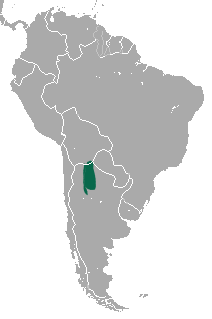Argentine fat-tailed mouse opossum
| Argentine fat-tailed mouse opossum | |
|---|---|
| Scientific classification | |
| Domain: | Eukaryota |
| Kingdom: | Animalia |
| Phylum: | Chordata |
| Class: | Mammalia |
| Infraclass: | Marsupialia |
| Order: | Didelphimorphia |
| Family: | Didelphidae |
| Genus: | Thylamys |
| Species: | T. sponsorius |
| Binomial name | |
| Thylamys sponsorius (Thomas, 1921) | |
 | |
| Argentine fat-tailed mouse opossum range | |
The Argentine fat-tailed mouse opossum (Thylamys sponsorius) was formerly considered a species of opossum in the family Didelphidae.[2] It is found in the eastern foothills of the Andes in northern Argentina and southern Bolivia.[1] Typically reach around 10-13 cm (4-5 inches) in body length, with a bushy tail adding another 12-15 cm (5-6 inches). Its dorsal fur is gray brown to dark brown. Its ventral fur is gray-based except for the white to yellowish chest hairs. It has been distinguished from T. cinderella by its postorbital ridges. T. cinderella has well-developed postorbital ridges in both juveniles and adults that extend laterally behind the eye sockets. Only adults of T. sponsorius have fully developed postorbital ridges, and these do not extend laterally behind the eye sockets.[3] While the American Society of Mammalogists maintains this as a distinct species,[4] mitochondrial DNA sequence analysis does not support the population being distinct from T. cinderella.[5][6]
References
[edit]- ^ a b Diaz M. & Barquez, R. (2008). "Thylamys sponsorius". IUCN Red List of Threatened Species. 2008. Archived from the original on 2016-07-08. Retrieved 20 March 2009.
- ^ Gardner, A.L. (2005). "Order Didelphimorphia". In Wilson, D.E.; Reeder, D.M (eds.). Mammal Species of the World: A Taxonomic and Geographic Reference (3rd ed.). Johns Hopkins University Press. p. 18. ISBN 978-0-8018-8221-0. OCLC 62265494.
- ^ Gardner, Alfred L. (2008). Mammals of South America: Marsupials, xenarthrans, shrews, and bats. University of Chicago Press. p. 669. ISBN 978-0-226-28240-4.
- ^ "Thylamys sponsorius (O. Thomas, 1921)". ASM Mammal Diversity Database. American Society of Mammalogists.
- ^ Flores, D. (2016). "Thylamys cinderella". IUCN Red List of Threatened Species. 2016: e.T51343307A22173237. doi:10.2305/IUCN.UK.2016-2.RLTS.T51343307A22173237.en. Retrieved 26 December 2019.
- ^ Braun, J.K.; et al. (2005). "Phylogenetic and biogeographic relationships of mouse opossums Thylamys (Didelphimorphia, Didelphidae) in southern South America". Journal of Mammalogy. 86 (1): 147–159. doi:10.1644/1545-1542(2005)086<0147:PABROM>2.0.CO;2.


 French
French Deutsch
Deutsch